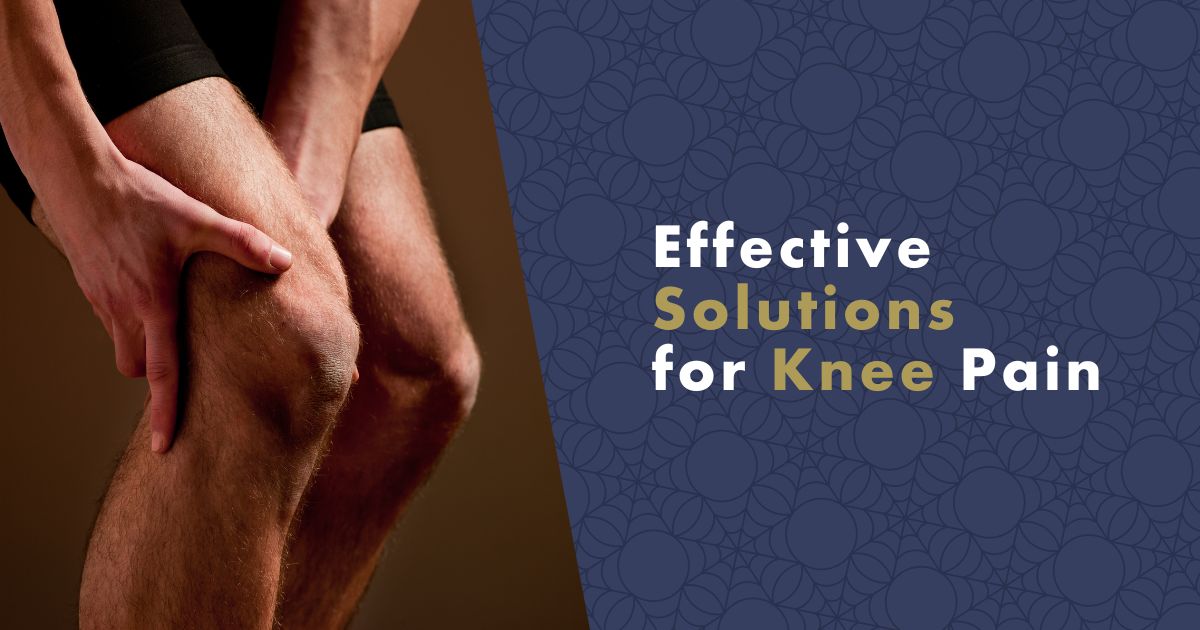Knee pain is a common issue that can affect people of all age groups. Pain in the knee can be caused by a range of factors, including excessive knee load, damage to joint structures, or various medical conditions. Today, we'll explore different types of knee pain, dietary supplements that can assist us, as well as other ways to find relief from pain.

Treatment for Knee Pain
The treatment for knee pain can vary depending on the underlying cause. In the case of damage to joint structures, effective approaches might include physiotherapy, pain medications, or surgical intervention. For inflammatory conditions like arthritis, anti-inflammatory medications, joint nutrition for people, or other dietary supplements containing chondroitin or glucosamine can be helpful. In conditions like osteoporosis, treatment with calcium and vitamin D might be beneficial.
Article Tip: Vitamin D Deficiency: How to Address It?
5 Tips to Alleviate Knee Pain
Let's explore some tips to manage knee pain.
1) Try Joint Nutrition
Joint nutrition is a type of dietary supplement designed to support joint health. It contains substances like collagen, chondroitin, and glucosamine, which are crucial for joint well-being. These compounds can help ease knee pain and enhance joint mobility.
Tip: Best Collagen for Skin, Hair, and Joints: What to Choose?
#produkty#https://www.nanospace.store/joints-dietary-supplements/
2) Stretching
Stretching before exercise is crucial as it helps prepare muscles and joints for subsequent performance. Stretching increases blood flow to the muscles, reducing the risk of knee pain caused by strained muscles that surround the knee joint.
3) Recognize Overexertion Early
If your knee starts hurting after demanding activities like a long run or lifting heavy weights, it might be a sign of overexertion. An overworked knee may feel warm, slightly swollen, and red. Local inflammation might be present, and it's essential to address it. Cooling the knee, elevating it, and providing rest are important. Avoid exacerbating inflammation by further strain. Gradually returning to exercise while listening to your body is crucial.
Article Tip: How to Choose the Best Winter Running Clothes?
4) Maintain Proper Body Posture and Sitting
Having correct body posture and sitting habits is extremely important not only for our spine but also for the health of our knees and other body parts. Learn to sit correctly, and if you experience knee and back pain, avoid low chairs and couches. Don't sit at the computer all day; take breaks and move around. Joints can "lock up" during extended periods of inactivity.
5) Don't Underestimate Footwear Choices
Improper foot mechanics can also cause knee pain. Barefoot shoes have been proven highly effective for foot and knee discomfort. If knee pain is caused by sports activities, make sure to wear quality sports shoes appropriate for the activity. Inadequate footwear can lead to more issues than just knee pain. You can also find products to improve footwear hygiene and odor reduction in the online store.

What Causes Knee Pain?
There are numerous potential causes of knee pain. The most common include strain or damage to ligaments, menisci, tendons, or the knee joint itself. Knee pain can also result from certain diseases like arthritis or osteoarthritis. If you experience knee pain, it's crucial to consult a doctor who can help identify the exact cause and recommend appropriate treatment. Some possible causes of knee pain include:
- Damage to joint structures such as ligaments, tendons, or cartilage.
- Inflammatory conditions like arthritis.
- Other diseases like osteoporosis.
- Excessive stress or trauma to the knee.
- Age-related changes, such as degeneration of joint cartilage.
- Congenital anomalies or developmental disorders of the knee joint.
- Certain infections like rheumatoid arthritis or Lyme disease.
Knee Pain During Squats
Knee pain that presents as a sensation of pain "inside" during exercises like squats or lunges might be caused by chondropathy or chondromalacia patellae, a condition involving cartilage beneath the kneecap. Bending the knee can compress this cartilage, leading to pain. Pain in the upper and lateral parts of the kneecap is also a common issue.
Tip: Magnesium Deficiency – and How to Quickly Replenish It
Knee Pain Behind the Knee
Knee pain behind the knee can have various causes not necessarily connected to previous issues. This type of pain can result from muscle cramps due to intense activity. Muscle cramps can be caused by tetany, dehydration, or liver conditions. Another possible cause of pain behind the knee is posterior cruciate ligament inflammation, known as "posterior cruciate ligament knee."
Burning Knee Pain
Burning knee pain is often caused by increased muscle tension in the inner knee muscles. This condition can be triggered by various factors, such as hip joint dysfunction, pelvic misalignment, or blocked spinal vertebrae. This pain can be uncomfortable and disrupt regular activities. If burning knee pain occurs, it's important to consult a doctor to determine the precise cause and recommend appropriate treatment.
Reducing Knee Swelling After Surgery
One way to reduce knee swelling after surgery is to perform an exercise where you lie on your back and extend the knee. During the exercise, it's important to tighten the quadriceps muscle and press the area just below the kneecap down onto the surface. This exercise should be repeated for 5 seconds, followed by knee relaxation. This exercise can help alleviate knee swelling and strengthen the lower part of the quadriceps muscle, crucial for walking and standing with a stabilized knee. It's important to consult a doctor or physiotherapist to ensure the exercise is suitable for your specific situation and being performed correctly.
Tip: How to Choose Compression Knee Socks?
How Long Does Knee Pain Last After Meniscus Surgery?
The duration of knee pain after meniscus surgery can vary depending on the type of procedure performed. While a straightforward surgery may cause pain for about a week, more complex procedures like repairing a torn meniscus can lead to pain lasting up to six weeks. Typically, recovery time after meniscus surgery ranges from two to four weeks, but it always depends on the severity of joint damage.
#produkty#https://www.nanospace.store/search/?string=collagen
What Is Osteoporosis?
Osteoporosis is a condition where bones become weaker and less dense, making them more brittle and susceptible to fractures. This condition is more common in older individuals but can occur at any age. Bones become less dense due to decreased bone tissue production and mineral loss, such as calcium. Osteoporosis can result in fractures, pain, and decreased bone size. Treatment for osteoporosis usually focuses on increasing bone density and reducing fracture risk. This may involve medications that increase bone tissue production or decrease its loss, along with dietary supplements rich in calcium and vitamin D.
Sources
- Zhang, Y., & Jordan, J. M. (2010). Epidemiology of osteoarthritis. Clinics in geriatric medicine, 26(3), 355-369. doi: 10.1016/j.cger.2010.03.001
- CLARK, Kristine L., et al. 24-Week study on the use of collagen hydrolysate as a dietary supplement in athletes with activity-related joint pain. Current medical research and opinion, 2008, 24.5: 1485-1496.
- Scott, D. L., & Wolfe, F. (2010). Painful joint conditions in adults. Oxford University Press. doi: 10.1093/med/9780199228364.001.000
- Hochberg, M. C., Silman, A. J., Smolen, J. S., Weinblatt, M. E., & Weisman, M. H. (2010). Rheumatology (Vol. 2). Mosby Elsevier.
- Hootman, J. M., Helmick, C. G., & Barbour, K. E. (2016). Updated projected prevalence of self-reported doctor-diagnosed arthritis and arthritis-attributable activity limitation among US adults, 2015-2040. Arthritis & rheumatology, 68(7), 1582-1587. doi: 10.1002/art.39692
- McAlindon, T. E., Bannuru, R. R., Sullivan, M. C., Arden, N. K., Berenbaum, F., Bierma-Zeinstra, S. M., ... & Kwoh, K. (2014). OARSI guidelines for the non-surgical management of knee osteoarthritis. Osteoarthritis and cartilage, 22(3), 363-388. doi: 10.1016/j.joca.2014.01.003
- Kerschbaumer, F., & Faschingbauer, M. (2018). Non-pharmacological treatment of osteoarthritis. Best practice & research Clinical rheumatology, 32(5), 589-603. doi: 10.1016/j.berh.2019.05.003
- Altman, R. D. (2009). Early management of osteoarthritis. American journal of managed care, 15(8), S236-S243.
- Firestein, G. S., Budd, R. C., Gabriel, S. E., McInnes, I. B., & O’Dell, J. R. (2016). Kelley and Firestein’s Textbook of Rheumatology E-Book. Elsevier Health Sciences.
- Cross, M., Smith, E., Hoy, D., Nolte, S., Ackerman, I., Fransen, M., & Bridgett, L. (2014). The global burden of hip and knee osteoarthritis: estimates from the global burden of disease 2010 study. Annals of the rheumatic diseases, 73(7), 1323-1330. doi: 10.1136/annrheumdis-2013-204763
- Yaffe, M. B. (2013). Editorial: Osteoarthritis: Is it time to shift the paradigm of care?. Arthritis & rheumatology, 65(3), 555-557. doi: 10.1002/art.37735

